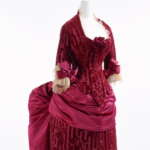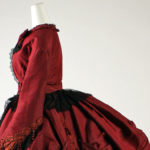Recent Essays
 fezIn 19th century, Asia, F, term definition
fezIn 19th century, Asia, F, term definition 1883 – Charles Frederick Worth, red silk satin and velvet dinner dressIn 1880-1889, 19th century, garment analysis
1883 – Charles Frederick Worth, red silk satin and velvet dinner dressIn 1880-1889, 19th century, garment analysis 15th century – Late Byzantine Silk Damask Dress and Taffeta TunicIn 15th century, Byzantine, garment analysis
15th century – Late Byzantine Silk Damask Dress and Taffeta TunicIn 15th century, Byzantine, garment analysis The Fez and the Ottoman Path to ModernityIn 19th century, 20th century, thematic essays
The Fez and the Ottoman Path to ModernityIn 19th century, 20th century, thematic essays 1869 – Red Silk DressIn 1860-1869, 19th century, garment analysis
1869 – Red Silk DressIn 1860-1869, 19th century, garment analysis
